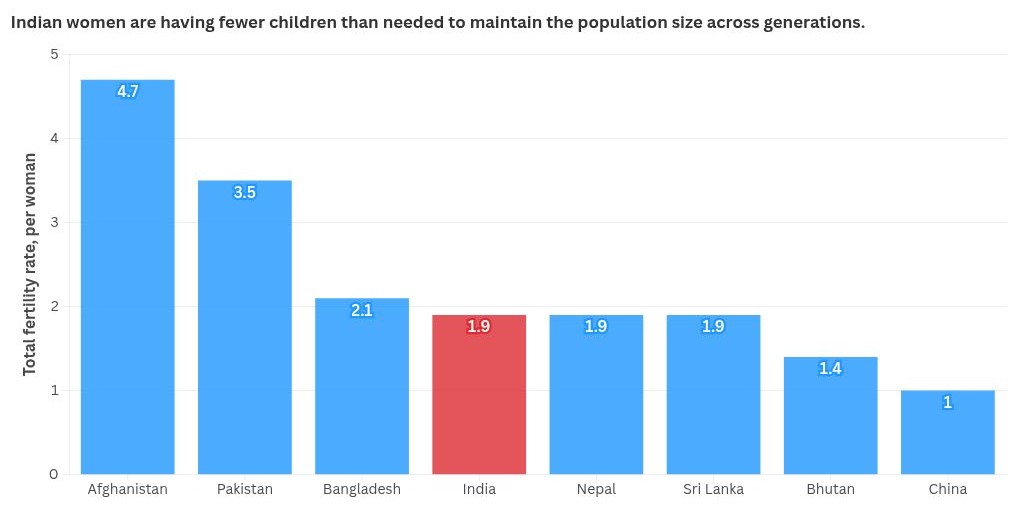Context:
India, now confirmed as the world’s most populous country, is witnessing a significant demographic transition, according to the United Nations Population Fund’s (UNFPA) latest report titled ‘State of the World Population 2025: The Real Fertility Crisis’. The report pegs India’s current population at 146.39 crore, ahead of China’s 141.61 crore.
Key Highlights:
1. Population Estimates and Projections
· As of April 2025, India’s population is estimated at 146.39 crore (1.4639 billion), surpassing China (141.61 crore) to become the world’s most populous nation.
· India’s population is projected to peak at approximately 170 crore over the next four decades, after which it is expected to enter a phase of gradual decline.
· These estimates are broadly in alignment with India’s Technical Group projections (2019), which placed the 2025 figure at 141.10 crore.
2. Decline in Fertility Rate
· The report indicates that India’s Total Fertility Rate (TFR) has declined to 1.9, falling below the replacement level of 2.1.
· This is corroborated by India’s Sample Registration System (SRS) 2021, which recorded a national TFR of 2.0.
· The reduction in TFR reflects structural changes such as higher female education, increased contraceptive use, delayed marriage, and urbanization.
3. Reframing the Fertility Crisis
· The report challenges prevailing narratives of overpopulation by identifying a new demographic concern: the unrealized fertility aspirations of individuals and couples.
· The so-called “real fertility crisis” refers to the inability of people to have the number of children they desire, often due to lack of access to reproductive healthcare, information, or autonomy.
· It emphasizes the importance of enabling reproductive agency—the right and ability to make informed, voluntary decisions about childbearing.
4. Youth Bulge and Working-Age Population
· India continues to possess a demographically young population:
o 24% of the population is aged 0–14 years
o 17% falls within the 10–19 years cohort
o 26% are aged 10–24 years
· A notable 68% of the population is in the working-age group (15–64 years), indicating a window of demographic dividend.
· Capitalizing on this dividend requires robust investments in education, health, skill development, and employment generation.
5. Ageing and Life Expectancy
· The proportion of elderly citizens (aged 65 and above) currently stands at 7%, and is projected to rise steadily as longevity increases.
· As of 2025, life expectancy at birth is estimated to be:
o 71 years for men
o 74 years for women
· This demographic shift signals the need for age-sensitive policies, including pension reforms, elderly healthcare, and social safety nets.
Delayed Census:
India has not conducted a Census since 2011, breaking its tradition of a decennial count. The 2021 Census has been postponed, with the government now targeting March 2027 for completion.
In the absence of recent census data, demographic assessments rely heavily on household surveys, including:
· Sample Registration System (SRS)
· National Family Health Surveys (NFHS)
· Demographic and Health Surveys (DHS)
· UN inter-agency and model-based estimates
Conclusion:
India stands at a demographic turning point. While population growth is slowing, the challenge now lies in harnessing the demographic dividend, supporting reproductive rights, and preparing for a gradual aging of the population. The upcoming Census 2026–27, delayed from 2021, will provide essential updated data to guide future planning.







